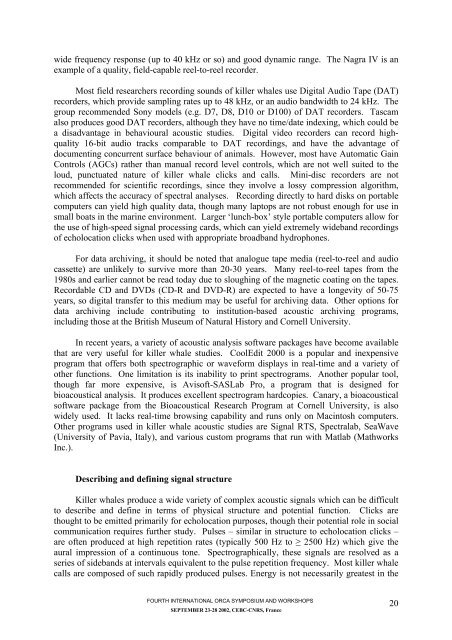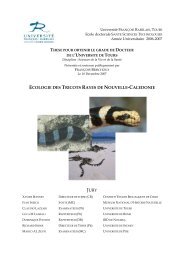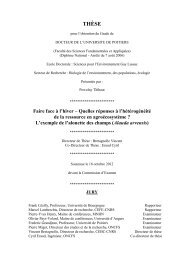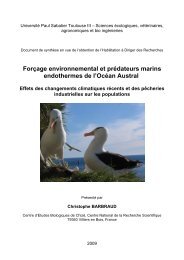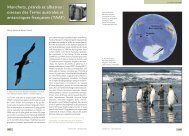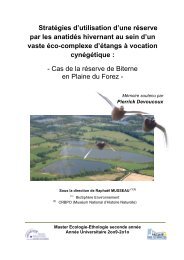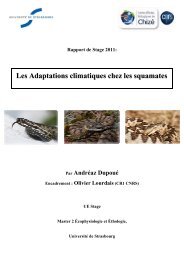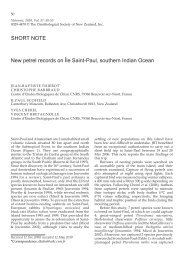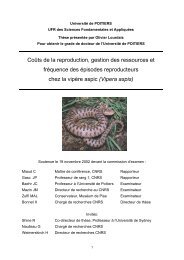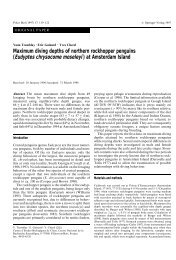Fourth International Orca Symposium and Workshop - CEBC - CNRS
Fourth International Orca Symposium and Workshop - CEBC - CNRS
Fourth International Orca Symposium and Workshop - CEBC - CNRS
Create successful ePaper yourself
Turn your PDF publications into a flip-book with our unique Google optimized e-Paper software.
wide frequency response (up to 40 kHz or so) <strong>and</strong> good dynamic range. The Nagra IV is an<br />
example of a quality, field-capable reel-to-reel recorder.<br />
Most field researchers recording sounds of killer whales use Digital Audio Tape (DAT)<br />
recorders, which provide sampling rates up to 48 kHz, or an audio b<strong>and</strong>width to 24 kHz. The<br />
group recommended Sony models (e.g. D7, D8, D10 or D100) of DAT recorders. Tascam<br />
also produces good DAT recorders, although they have no time/date indexing, which could be<br />
a disadvantage in behavioural acoustic studies. Digital video recorders can record highquality<br />
16-bit audio tracks comparable to DAT recordings, <strong>and</strong> have the advantage of<br />
documenting concurrent surface behaviour of animals. However, most have Automatic Gain<br />
Controls (AGCs) rather than manual record level controls, which are not well suited to the<br />
loud, punctuated nature of killer whale clicks <strong>and</strong> calls. Mini-disc recorders are not<br />
recommended for scientific recordings, since they involve a lossy compression algorithm,<br />
which affects the accuracy of spectral analyses. Recording directly to hard disks on portable<br />
computers can yield high quality data, though many laptops are not robust enough for use in<br />
small boats in the marine environment. Larger ‘lunch-box’ style portable computers allow for<br />
the use of high-speed signal processing cards, which can yield extremely wideb<strong>and</strong> recordings<br />
of echolocation clicks when used with appropriate broadb<strong>and</strong> hydrophones.<br />
For data archiving, it should be noted that analogue tape media (reel-to-reel <strong>and</strong> audio<br />
cassette) are unlikely to survive more than 20-30 years. Many reel-to-reel tapes from the<br />
1980s <strong>and</strong> earlier cannot be read today due to sloughing of the magnetic coating on the tapes.<br />
Recordable CD <strong>and</strong> DVDs (CD-R <strong>and</strong> DVD-R) are expected to have a longevity of 50-75<br />
years, so digital transfer to this medium may be useful for archiving data. Other options for<br />
data archiving include contributing to institution-based acoustic archiving programs,<br />
including those at the British Museum of Natural History <strong>and</strong> Cornell University.<br />
In recent years, a variety of acoustic analysis software packages have become available<br />
that are very useful for killer whale studies. CoolEdit 2000 is a popular <strong>and</strong> inexpensive<br />
program that offers both spectrographic or waveform displays in real-time <strong>and</strong> a variety of<br />
other functions. One limitation is its inability to print spectrograms. Another popular tool,<br />
though far more expensive, is Avisoft-SASLab Pro, a program that is designed for<br />
bioacoustical analysis. It produces excellent spectrogram hardcopies. Canary, a bioacoustical<br />
software package from the Bioacoustical Research Program at Cornell University, is also<br />
widely used. It lacks real-time browsing capability <strong>and</strong> runs only on Macintosh computers.<br />
Other programs used in killer whale acoustic studies are Signal RTS, Spectralab, SeaWave<br />
(University of Pavia, Italy), <strong>and</strong> various custom programs that run with Matlab (Mathworks<br />
Inc.).<br />
Describing <strong>and</strong> defining signal structure<br />
Killer whales produce a wide variety of complex acoustic signals which can be difficult<br />
to describe <strong>and</strong> define in terms of physical structure <strong>and</strong> potential function. Clicks are<br />
thought to be emitted primarily for echolocation purposes, though their potential role in social<br />
communication requires further study. Pulses – similar in structure to echolocation clicks –<br />
are often produced at high repetition rates (typically 500 Hz to ≥ 2500 Hz) which give the<br />
aural impression of a continuous tone. Spectrographically, these signals are resolved as a<br />
series of sideb<strong>and</strong>s at intervals equivalent to the pulse repetition frequency. Most killer whale<br />
calls are composed of such rapidly produced pulses. Energy is not necessarily greatest in the<br />
FOURTH INTERNATIONAL ORCA SYMPOSIUM AND WORKSHOPS<br />
SEPTEMBER 23-28 2002, <strong>CEBC</strong>-<strong>CNRS</strong>, France<br />
20


